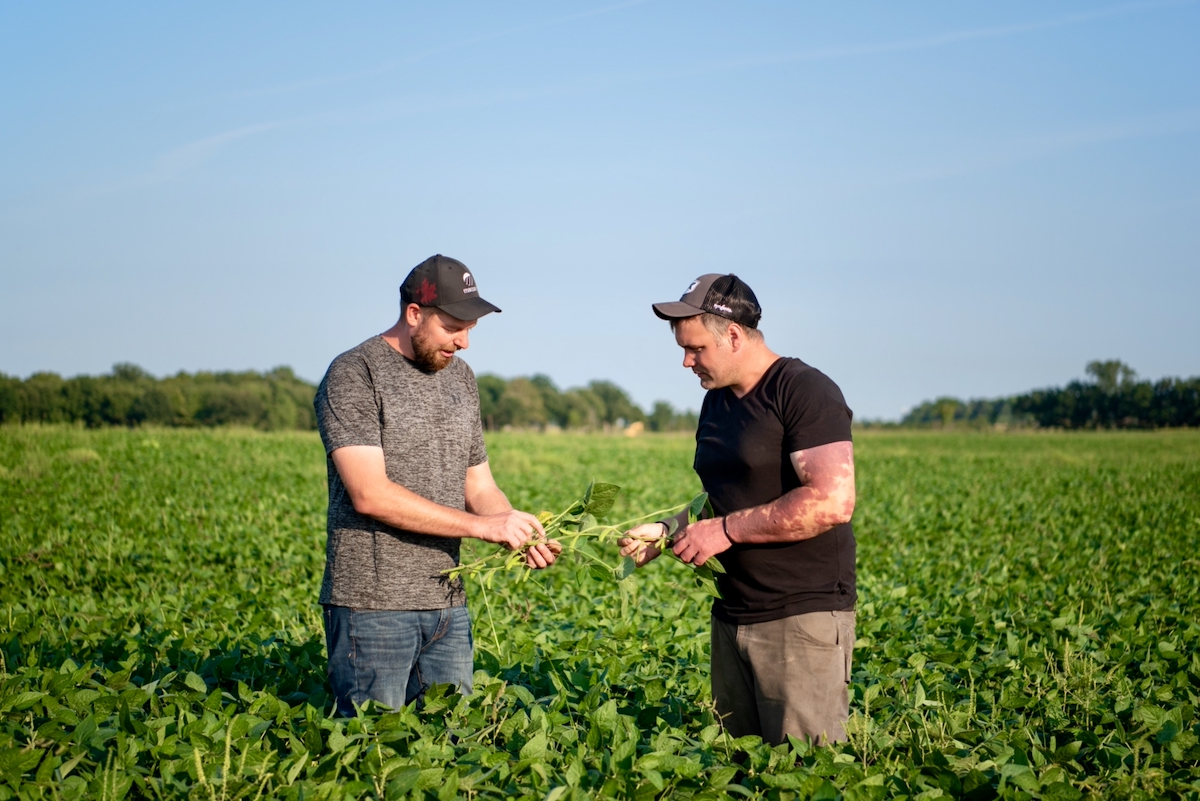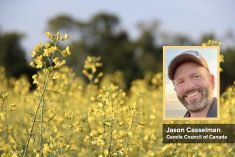Over the past dozen years the canola industry has poured an ocean of effort into halting the spread of clubroot around the Edmonton area.
And while there have been advances such as new resistant varieties, one uncomfortable truth remains — the disease continues to spread.
Dan Orchard, a Canola Council of Canada agronomist who discovered the first infected field in 2003, says clubroot has kept on marching outward without even missing a beat.
“It continues to advance about 30 kilometres a year,” Orchard told Country Guide during a recent conversation. “It’s still spreading at its own pace.”
Read Also

Ontario farmers partner for success
Ontario business partners, Matt Bergman and DJ Wassenaar, have been farming together for 10 years. Their focus on integrating unconventional…
While that’s frustrating for everyone in the area, Orchard says that continued spread is not a foregone conclusion and that it might be time to rethink the control methods and begin to work proactively to root the problem out while we still have the opportunity.
That means getting out into fields and identifying the problem early, rather than waiting until the signs are obvious and the grower is suddenly dealing with a crisis and trying to slam the barn door shut long after the horse is already out.
Orchard says agronomists like him bear some responsibility for not fully understanding the disease earlier and for making recommendations such as looking for affected patches in the field while driving by, or identifying unusual patches of premature ripening from the swather.
“We know now that was a bad message,” he concedes frankly. “We should have been telling growers to get out and look for it before they think they have a problem, before it becomes so obvious. Checking entrances, waterways, low areas and other ‘hot spots’ before seeing above-ground symptoms is imperative to catching it early.”
Breaking the wheat-canola habit
Getting ahead of the problem is going to pay growers dividends, but it won’t necessarily be easy. For example, there’s the question of crop rotations that are in a lot of cases too tight. The recommendation for clubroot and blackleg management is once every four years, but many growers around Edmonton are still growing wheat and canola back to back.
In a lot of ways it’s a holdover from the bad old days of the 1980s and ’90s, when Prairie growers were holding on for dear life and had no choice but to push canola rotations. If they hadn’t, they’d quickly have been out of business. They soon learned how to manage a two-year rotation successfully, and many continue to do so, but the level of management is becoming increasingly intense, especially if pests become a problem.
These days other crops are starting to pay bills a bit more reliably, and there are options to canola. However, getting growers to adopt them may not be easy.
“I think it’s habit,” Orchard said. “Farmers are just like everyone else — they like a routine that works for them, and growing canola and wheat is comparatively easy, and with the absence of disease there isn’t really a yield penalty with this rotation.”
Modern canola hybrids are tough and resilient, and weed control is a relative snap with herbicide-tolerant traits. Wheat and canola are also both relatively easy to store, market and move when compared to other crops like oats or field peas, for example. And other options, such as growing dehy alfalfa, remain niche markets at best, are simply unable to soak up the acres required for a wholesale change to cropping systems.
“It’s not an easy challenge for growers, there’s no denying that,” Orchard said. “But it’s a necessary one, I think, especially in the clubroot-affected regions.”
That conviction stems from another uncomfortable reality that’s emerged as he’s watched the disease inexorably marching through the region — that sooner or later life is going to get complicated for canola growers. The response can either be front loaded as a preventive strategy, or back loaded as a mad scramble while trying to stay in the canola game. Neither are simple, but at least getting ahead of the game gives you some time to deal with the problem before it’s a crisis, which Orchard says appears to be the better solution.
“There are farmers out there, right in the middle of the most affected areas, and clubroot has very little impact on their farm,” Orchard said. “Continually scouting for the disease and deploying resistant varieties has been their only change.”
No simple solutions
One thing that has become apparent is there don’t appear to be any easy solutions.
For example, just a few years ago growers were excited by the introduction of the first clubroot-resistant canola varieties — but that excitement proved to be short lived. Already the region has seen evidence of a pathogen shift which is able to overcome resistance after just a couple of seasons. This is most likely due to natural variations within the clubroot population, as recent field surveys have shown new strains popping up.
Just a year ago a new strain dubbed “5x” had the industry concerned because it was found to have overcome the genetic resistance of available varieties. This past season the news got even worse, with a further nine new strains identified, all capable of overcoming the available genetic resistance. In all likelihood this is a result of the application of selection pressure by using resistant varieties too frequently.
“It’s like using the same antibiotic over and over again,” Orchard said. “Sooner or later you’ll wear out that antibiotic as the disease becomes resistant, and it would appear the same sort of thing is happening here.”
Plant pathologist Stephen Strelkov of the University of Alberta has become one of the world’s foremost experts on the disease over the past dozen years, and he agrees with Orchard’s analysis. We reached him in France, where he’s spending a few months of sabbatical time doing research at that country’s national agriculture research institute.
Strelkov says clubroot appears to have fairly variable populations, making it extremely adaptable to control measures, and thus very successful at overcoming genetic resistance in short order.
“What we’ve seen isn’t anything too surprising,” he told Guide. “It’s what we’ve seen in other countries where they grow susceptible crops, and what’s been observed in greenhouse trials.”
Strelkov says this reality highlights the necessity for growers to move to longer rotations in affected areas, rather than burning through the available genetic resistance, something that’s likely to become harder and harder for plant breeders to identify and put to work.
“I think we are picking the low-hanging fruit right now, and it’s only going to become a bigger challenge,” Strelkov said.
It all adds up to thinking very carefully about how the new clubroot-resistant varieties are deployed. Growers in the most affected areas can’t just assume they’ll be able to keep doing what they’ve been doing and depending on the varieties to hold up.
“Longer rotations are going to be the key because of what we know about the life cycle of the disease and its ability to remain in the soil for long periods of time,” Strelkov said. “Shorter rotations cause the inoculum to build very quickly to levels that will seriously impact canola production. The simple truth is that these growers are going to be faced with a longer canola rotation, one way or another. Either they get ahead of the problem themselves, or the disease will end up enforcing a rotation by default.”
Start at the fringe
One of the strategies that’s beginning to come to the forefront is encouraging growers to plant resistant varieties in the fringe areas where the disease is either new, or as yet unidentified but on the horizon. This could beat down a potential infection that’s currently asymptomatic because the spore load in the soil isn’t high enough to cause visible damage. It’s like vaccinating to prevent a disease rather than trying to fight the infection later.
Orchard said that while tools like genetic resistance will remain important, other strategies will be necessary to slow the disease’s spread and ease the pressure on this single, most valuable tool.
A small outbreak spotted early might be dealt with relatively easily by managing that patch separately.
“You might seed around it, or sow it down to a non-susceptible crop like grass, or even treat it with some of the soil treatments that have been used in other places where clubroot has been a problem, such as lime or fungicides,” Orchard said.
Other strategies might include reducing the viability of spores, including one unique strategy involving so-called “bait crops” such as ryegrass. This aims to take advantage of a quirk in the life cycle of clubroot where, when it uses certain crops as a host, or some reason it never matures to the point that it produces new soil-borne inoculum.
“It takes the clubroot spores out of dormancy, but then there’s no host available that allows them to complete their life cycle,” Orchard said.
Clubroot bloodhound
Both Strelkov and Orchard say the key to stopping the spread is scouting fields where the problem isn’t obvious, but where it’s likely to appear next. And for the inside story on best scouting practices, they both referred to Victor Manolii, a senior research technician working in Strelkov’s team at the University of Alberta.
“He’s the best clubroot scout I’ve ever seen,” Orchard said. “Watching him work is like watching a bloodhound or a drug-sniffing dog. He’s just amazing at finding this disease.”

Strelkov said after identifying several thousand cases throughout the province, Manolii is “the best in the world” at scouting clubroot infections.
We reached Manolii on his mobile phone while he was en route to a field visit in Alberta’s Two Hills County with the local agriculture agent, and he ran us through some of the key points to effective scouting.
The first and most important thing to understand is how the disease is entering fields, Manolii said. While wind and water erosion can move it in from adjacent fields, the main culprit is very clear.
“The majority of cases — 90 per cent or a bit more — is coming in on infested soil that’s being moved by equipment,” he said.
Those aren’t necessarily tillage implements either. Spores can come in on any equipment including combines, swathers, grain trucks, oilfield equipment and even with beekeepers as they tend their hives.
That might sound frustrating, but it leaves an obvious place to start scouting.
“Start at the main entrance to the field, and scout there,” Manolii said. “Even more than that, there’s a very clear-cut pattern that most farmers turn to the right when they enter a field and start a field operation, so scout at the entrance and to the right of it.”
There are two main ways to scout for this problem. You can pull plants that aren’t looking healthy and see if you can find galls on the roots — but by then you’ve already got a reasonably serious problem. Or you can take soil tests or root tissue samples and send them to a laboratory for analysis where a reasonably priced test can determine if the field has inoculum present at low levels.
“There are both root tissue and soil tests using PCR (Polymerase chain reaction) technology, which can be very accurate,” Manolii said.
It’s a relatively affordable process as well, with fees running under $100 a test at most commercial labs.
Getting the test done early can be cheap insurance against a runaway problem, Manolii said, insisting a grower is always going to be better off knowing if the problem is present or not. If it is, but isn’t a huge issue yet, it will be cheaper and easier to manage and you might even get away with no significant economic damage ever happening.
Manolii said that as well as the field entrances, growers should pay attention to places where water might be moving the inoculum into a field, like a water run, and low spots within the field, where the inoculum could be accumulating. He also said growers should pay particular attention to canola fields in late July and early August.
“This is when the fields will be nice and green, and you want to be looking for brownish patches, spots where the plants may already be dying.” Manolii said the cause might not be clubroot — it could be sclerotinia, blackleg or even just too much water — but if you see it, you should check it out.
He concurs that getting on the problem early is going to be the best strategy, and is similarly concerned at the way the disease continues to march outwards.
“We need to slow it down,” he said.
Orchard still thinks that’s possible, but to do so, it’s going to be important to get ahead of the problem and work back in, much like a controlled burn can stop a forest fire from spreading further.
“If we can start working back towards it, rather than chasing after it, I really do think we can slow it down,” Orchard said. “We might be able to take it from spreading 30 kilometres a year to just three.”
This article was originally published as ‘Clubroot marches on’ in the November 2015 issue of Country Guide.
Clubroot by the numbers
- 2003 the year clubroot was first discovered in a canola field near Edmonton.
- 1,000 the minimum number of affected fields in the province of Alberta.
- 25 the number of Alberta counties that have had clubroot detected within their boundaries.
- 2005 the year clubroot was first found in canola in Manitoba.
- 2011 the next time the pathogen was detected in that province.
- 10 the number of Manitoba municipalities affected by clubroot.
- 2008 the first year the clubroot pathogen was detected in Saskatchewan soil samples.
- 30 the number of randomly selected fields in that survey of the province.
- 2011 the year clubroot was first identified in canola plants in Saskatchewan.
- 2 the number of affected rural municipalities in Saskatchewan.
- 7 the number of remaining clubroot-resistant varieties as of august 2014.
- 2 the number of clubroot- resistant varieties clubroot has overcome resistance to in some areas.
- 1 in 4 the recommended rotation for canola to prevent clubroot, blackleg and other disease pressure from building.
- 2 the observed number of rotations for clubroot resistance to begin to fail.
- 10 the number of seasons researchers say it should have taken if proper rotation had been followed.
- 2013 the year the first clubroot- resistant varieties failed.
















